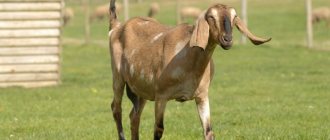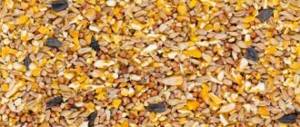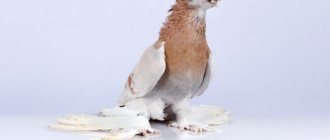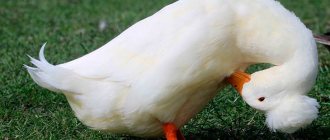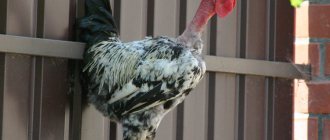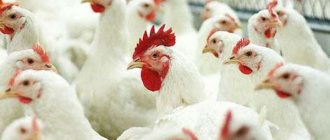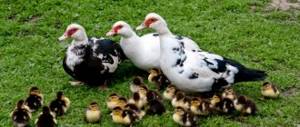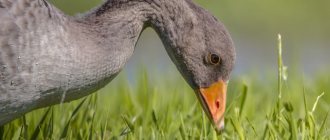Advantages
The growing popularity of these birds is easily explained by their numerous advantages, including:
- Fast maturation. The female is ready to produce offspring at the age of 8 months. From it you can get 2 clutches of eggs per year.
- Egg productivity. One clutch on average consists of 45 eggs. Each egg is medium in size and weighs about 165 g. One goose can produce approximately 90 eggs per year.
- High survival rate of young animals. 70-80% of goslings from each clutch survive. Female Italian geese have a particularly developed maternal instinct and take good care of their offspring, so there is no need to use incubators or brood hens.
- Taste of meat. The meat obtained by crossing Italian geese with representatives of other breeds is especially valued. If you breed a female with a selected large gander of a different breed, you can get excellent offspring.
- The down and feathers are white and are used in the textile industry and art.
- Adaptability and low maintenance requirements.
- The duration of the profitable period is up to 5 years.
Farmers say that all costs for Italian geese are completely worth it. The main thing is to approach bird care wisely and follow the basic rules.
Italian geese adapt well to different climatic conditions. They were bred in the hot Italian climate, but they tolerate the cold of northern countries well. There are several rules for caring for these birds.
- For Italian geese, cleanliness in the room where they are kept is vital. It is necessary to maintain dryness and remove droppings regularly. You should also disinfect and fight parasites approximately every six months, change bedding and perches. It is recommended to use sawdust as flooring in the poultry house, and in cold weather - an insulated version with peat. We must not forget to ventilate the gooseneck and walk the winged ones in warm weather.
- Birds should be fed frequently and nutritiously, providing them with all the necessary vitamins and minerals. In addition to the berries and plants that geese will eat while grazing in a meadow or pasture, the diet includes various feeds, grains, animal proteins, calcium-rich foods (chalk, shells), and vegetables.
- The water in the drinking trough should be as clean as possible, preferably running, so that the infection is not transmitted to the entire herd.
- Geese love to swim, so it makes sense to build them a swimming pond.
You can see the Italian goose in more detail in the photo above.
Description of the breed and distinctive features
The Governor's goose, although obtained by crossing 2 breeds, is more similar to the Italian variety of bird, so many poultry farmers often confuse them. This is a middle class breed, meat and egg production, with a maximum weight of 6 kg.
Appearance
Features of appearance indicators:
- plumage – predominantly white;
- head – small in size, oblong in shape;
- beak – shortened, orange-red;
- neck – medium length;
- physique – compact;
- fluff of a branched structure;
- the caudal process is small in size;
- the chest is quite strong;
- the paws are red-red in color;
- there is no fold under the beak;
- there is no forehead bump.
At a young age, goslings differ in external characteristics from adults - the fluff contains inclusions of gray color. As they grow, they molt, during which the plumage becomes snow-white.
Character
These are quite peaceful birds, distinguished by their majestic posture and important gait. Despite their slowness, when danger approaches, they actively engage in battle.
Egg laying period and average annual egg production
The egg-laying time of a goose is 4-4.5 months. During this period, according to average indicators, she is capable of laying 43-46 eggs. The average annual egg production is 98-100 eggs per female, therefore, when raising a large population, there is enough product for absolutely all purposes - consumption, sale, breeding.
Individual weight, rate of early maturity
Governor's geese are quite early-ripening, although they have a small weight for this type of bird (average 5-6 kg). Already by 9 weeks, the weight of the gander is at least 4.3 kg, while the goose weighs 300-400 grams less. By 3 months of life, the goose already weighs a full 5 kg in the form of a dressed carcass, and this is with a feed consumption of 3 kg per 1 kg of live weight gain.
Goose farm as a profitable business
When breeding geese at home as a means of making money, you should study the market in detail and calculate the financial part. Goose farming in Russia is quite a profitable business. The market is constantly experiencing a shortage of these products, and breeding is associated with small expenses and risks.
For example, let’s take a farm with 1000 livestock.
Expenses
- Construction of premises with land or its rent – 250,000-300,000 thousand rubles.
- Equipment - up to 150,000 rubles.
- Preparation of documentation – up to 20,000 rubles.
- Purchase of goslings - about 50,000 rubles.
- Feed - about 600,000 rubles.
General: RUB 1,120,000
Profit
- Meat (at the rate of 1,000 rubles per carcass and 500 rubles per liver) – 1,500,000 rubles.
- Down and feather – 20,000 rubles.
Total: RUB 1,520,000
However, losses due to illness and other unforeseen expenses should be taken into account. It is believed that the payback period for a goose farm is estimated at 1-2 years. Currently, the business for the production of goose products is quite actively developing in Russia. One of the many such enterprises in this segment are: Gusevod Kubani LLC, Agro. These farms have some of the largest herds in Krasnodar. The number of heads exceeds 10,000. Individuals on them are distinguished by high egg production and a fairly large body weight. They handle a wide range of hatchery work. The fertilization rate of eggs at these enterprises reaches 90%.
Geese breeding as a business
The business of breeding geese is a troublesome, but profitable business.
The main advantages of the enterprise:
- a pair of geese per season will bring profit equivalent to an eight-month-old piglet;
- minimal food costs: the main food of poultry is green fodder (80%), the presence of a neighboring meadow or the possibility of harvesting grass yourself will bring excellent investment savings and profit on weight gain;
- Not only meat can be sold: liver and fluff are in stable demand on the market;
- short terms of income generation: the weight of a gosling increases 45 times in two months, with the cost of feed and care, the profitability will be 115%;
- an additional bonus is an environmentally friendly fertilizer: poultry droppings will increase the fertility of the land by 1.5 times.
We recommend that you learn about raising geese as a business.
The benefits of breeding and raising meat breeds of geese are obvious: obtaining consistently high profits and providing the family with fresh, high-quality dietary meat.
What are the pros and cons of the breed?
Also check out these articles
- Planting cucumbers in open ground
- Pig litter with bacteria
- Raising broiler turkeys
- Chinese cabbage
When breeding, breeders tried to increase the productive performance of the bird in all respects, so that the breeders received a whole range of qualities, and not just one thing (meat, fluff or eggs), as is usually the case with poultry breeding. So, what are the advantages of the governor's look?
The meat is juicy, healthy, incredibly tasty and, accordingly, expensive, valued by chefs from all over the world.
- The average egg production per year is 100 eggs. Geese lay eggs once every six months, so in half a season they get about 50 eggs from one female. If the population is large, then there will be enough eggs for breeding, consumption and sale.
- Governor's geese are early maturing and quickly gain the required weight. At 2 months they almost reach the weight of an adult bird. Females - 4 kg, males - 4.5 kg. The meat is juicy, healthy, incredibly tasty and, accordingly, expensive, and is valued by chefs from all over the world.
- The fertilization of the eggs obtained is 90%, the survival rate of the young is 95-99%! Such indicators are rare when considering the characteristics of other breeds.
- The bird also produces valuable, high-quality down feathers. It can be used for your own needs, in handicrafts, or sold in bulk to specialized factories.
The disadvantages of the species include the costs of feeding and arranging the poultry house. So, for a potential weight gain of 1 kg, approximately 3 kg of feed is consumed. This is a large number, but the breed pays for the cost of its maintenance, so the expenses are justified.
What and how to feed geese correctly?
We recommend reading our other articles
- Grape variety Timur
- Recipes for crispy lightly salted cucumbers
- What not to feed rabbits
- Plum variety Hungarian
Approximate rate of feed consumption per 1 goose (g)
Feeding is predominantly pasture. But in the goose barn they are given compound feed and mash in the evening and morning. The first in the morning, the second in the evening. In winter, the Governor breed of geese is always in the goose barn. Meals are divided into 3-4 times. In winter, it is important to feed birds with vitamins in order to increase resistance to disease and improve the condition of the down, which can worsen without an abundance of light.
The winter diet is made up of mixed feed and mash. You either buy compound feed or make it yourself. It necessarily includes ground grain, wheat bran, peas, beans, lentils, vitamins, and minerals. Mashes are made from hay dust, potatoes, pumpkins, beets, nettles, rutabaga, silage and turnips.
The water is fresh and clean, changes daily or even several times a day. Dirt in the drinking bowl can breed germs and parasites. There should always be chopped shell in a separate bowl.
Appearance and characteristics
The down of the described birds is unique in color, thick, dense, and heat-insulating. Representatives of the breed are not susceptible to eye diseases, like many of their relatives. Young individuals are gray speckled in color, but with age, after molting, the plumage becomes lighter.
From their Italian ancestors, our heroes inherited most of the features of their appearance, although ennobled, with greater majesty. With proper feeding, by the age of two months the goose weighs about 4 kg, and the gander can gain up to 4.4 kg. To have a clear idea of what such birds look like, it’s worth looking at their photos on the Internet.
Reviews from breeders indicate that Governor's geese, a description of the breed, photos of which are presented in the article, deserve to be kept at home. Their productive characteristics are very pleasing even to novice farmers. But what are the advantages of raising geese on the farm?
In the photo you can see that the Governor's geese look very attractive. They were bred by breeders at the beginning of the 21st century, but despite their “youth” they are in deserved demand. Complex random crossing of the Shadrinskaya and Italian breeds of geese led to the appearance of the Gubernatorskaya.
In the photo you can see that the Governor's geese look very attractive. They were bred by breeders at the beginning of the 21st century, but despite their “youth” they are in deserved demand.
Colorsex coloration of the down of a small gosling and young animals – features of the chicks of this breed. They also differ in other exterior characteristics, namely:
- compact build;
- small neck;
- broad chest;
- orange beak and legs;
- small head;
- absence of cones in geese.
Many people seek to buy Governor's geese for breeding at home. The price of birds is quite reasonable and affordable. According to reviews, the Governor breed of geese has more advantages than disadvantages. The main advantages include:
- excellent characteristics of egg production and meat productivity;
- excellent survival rate of young animals, approximately 95%;
- rapid growth rate of poultry;
- polygamy and fertility of geese;
- birds' ease of care and other characteristics.
It is worth noting that the live weight of males at 9 months of age is about 4.5 kg, and that of geese – about 4 kg. Breeders are pleased with the fact that feed consumption is absolutely small. Egg production rates may vary, but on average a goose produces approximately 46 eggs per year. By watching a video about the Governor breed of geese, you can learn more about their character, characteristics, and appearance.
By spring, the geese were ripe and pleased with their eggs. Their eggs are very large, but they actually lay very few. It was enough for me though.
Tags: governor's, goose, description
About the author: admin4ik
« Previous entry
What is different about the Linda goose?
The breed was approved in 1994. Its homeland can be considered the Nizhny Novgorod region, where the species was bred by crossing Chinese waterfowl (which determined endurance) and Russian birds, after which Adler and Solnechnogorsk geese were introduced into the genus to improve cover and accelerate growth. In order to improve the quality of feathers and down and make them heavier, the birds were crossed with the Arzamas and Landes breeds. Subsequently, these geese were mated only with each other
But for an ordinary person it is hardly important how the bird is bred; what is much more important is the fact that it gives and what advantages it has
Geese of the Linda breed are distinguished from their species by their large weight indicators: their weight under good conditions reaches 12 kg, and on average is 8 kg. Lindovsky geese have white plumage, on which dark tan marks can sometimes be seen, a massive and elongated body, short but large orange legs.
If you get a couple dozen of these geese, they can provide the owner with a large amount of dietary meat, beautiful down and eggs all year round.
The Linda goose has a number of advantages compared to other breeds:
- Enormous fertility. This meat breed of geese is characterized by an extremely high degree of productivity. Each goose per year is capable of laying up to 50 eggs weighing from 140 to 170 g. Almost 90% of them are fertilized, and thanks to the vitality of the breed and the good hatching abilities of the females, almost all the chicks survive. Lindovsky geese are also distinguished by excellent hatchability and extreme viability of the young.
- High quality and quantity of meat. The meat of Linda geese is characterized by excellent taste: it is tender, soft and juicy, has a pleasant smell and characteristic taste, and most importantly, does not lose its properties even after deep freezing. These birds have a standard set of bones, but they produce meat many times more than other breeds. Each of the geese, with proper nutrition, already weighs about 4 kg at 2 months, and in a year reaches a weight of 10 kg, given that they eat quite a bit. This is why the breed is so loved by farmers and people who raise birds for sale.
- Excellent level of adaptation. Since Lindovsky geese were obtained through crossing, they are endowed with excellent immunity to various diseases, durability, a high degree of adaptation to climate change and frost resistance. It should be borne in mind that geese of European breeds can get sick even with a slight drop in temperature.
- Friendly character. Linda's geese are distinguished by their peacefulness and calmness. They are kind and inquisitive, have excellent contact with people, and get along with their brothers and birds of other breeds. As a rule, birds move calmly in search of food or rest near water.
Geese of the Linda breed are distinguished from their species by their large weight indicators: their weight under good conditions reaches 12 kg, and on average is 8 kg.
The only disadvantage of Lindovsky geese is their tendency to develop a disease such as hymenolipetosis. In most cases, young birds are affected by it, since their stomach is not yet adapted to eating various inhabitants of water bodies. To prevent the disease, it is necessary to mix a small amount of algae into the goslings’ food, and then fish. But this minus cannot spoil the overall impression, since there are clearly more advantages. Therefore, when choosing a bird breed to raise, it makes sense to choose this one.
4lapki.com
External characteristics
During breeding, breeders managed to combine the positive characteristics of the Landes and Toulouse geese. The standard description of the breed has the following characteristics.
- White feathers have a dense structure and do not allow water to pass through. Down feathers are soft and perfect for bedding.
- The male mamut reaches 10-13 kg, the average weight of the female is 8-9 kg.
- There is no bump on the beak.
- The neck is not too long, proportional to the body of the bird.
- The legs and beak are bright orange with a pink undertone.
Behind the standard description lies a beautiful bird larger than an ordinary goose. Unlike other breeds, the gene pool has good immunity and resistance to infections. Out of 10 goslings, at least 8-9 individuals survive under normal conditions. They have an excellent appetite, so when fattening they often show a weight of over 14 kg without excess fat.
Advantages:
- high quality meat;
- ease of catering;
- rapid weight gain;
- early reproduction – from 6 months;
- excellent egg production.
Mamuts are unpretentious birds that, when consuming food of no more than 90-95 kg per year, give a large increase in weight. Therefore, farmers prefer to breed them to quickly make a profit in the spring-summer season: after 8-9 weeks, the young animals reach 6 kg in weight. The only disadvantages that can be noted are that geese of this breed are quite expensive, in addition, females may refuse to hatch eggs.
Watch the video about the Mamut geese breed below.
Maintenance and care
The Governor breed is unpretentious in maintenance and care, therefore it is grown in large and small farms. Immediately after birth, sex can be distinguished, so at this stage the geese are separated from the geese.
The breed is kept in any climatic conditions, as it is frost-resistant. Birds easily tolerate transportation, after which diseases do not occur, but productivity is slightly reduced (during adaptation).
Premises requirements
Geese are birds that breed dampness (splash water, bathe), so there are special requirements for the premises:
- It is better to fill the floor with concrete and equip it with wooden flooring. If this is not possible, then it is important to fill the floor with wood shavings or sawdust, straw, or hay. A prerequisite is that when the material gets wet, it is replaced.
- Geese need a spacious room, but it must be divided into sections with 50 heads in one sector. The partition is constructed from an ordinary metal mesh with a height of 1.3-1.5 m. This is necessary so that birds cannot fly over.
- Ventilation is required, as is artificial lighting, especially in cloudy weather.
- Insulation for the winter is carried out from the inside and outside. For this you can use any available material.
- Drafts are completely eliminated, otherwise the livestock will get sick.
Pasture area for walking
The dynamism of geese requires movement, so the birds need to be provided with a place to roam. To do this, there is a free exit from the poultry house to the pasture, which can be open or closed. Since birds can fly over obstacles, the fence should be at least one and a half meters high. The best option is a mesh enclosure.
Pasture requirements:
- it is possible to create an artificial reservoir (trough, ditch, etc.);
- a lot of greenery (grass);
- you can use the land on which cereals and other crops grew (geese will peck out the remaining grains);
- absence of dry grass (mow if necessary).
Access to water
Governor's geese drink constantly, so access to water must be open. For this purpose, artificial reservoirs or drinking bowls are used. The latter are sold in specialized stores, but you can also make them yourself. The main requirement for a drinking bowl is the shape of the gutter.
To prevent diseases, experts advise installing containers not only with clean water, but also with decoctions of medicinal herbs (chamomile, etc.). There is no need to drink healing drinks every day; 3 times a week is enough.
Feeders, drinkers and sand troughs
How to properly equip the necessary equipment for geese:
- The feeder should be accessible to absolutely all individuals of the flock, and at the same time. This is due to the fact that geese are constantly eating and nibbling something. Feeders must be long (at least 2 meters). The size is calculated based on the requirements: for one individual, 25-30 cm is required. For the convenience of the birds, it is more advisable to hang devices at a height of 15-20 cm from the floor level.
- Drinkers should always be within sight of the geese. These birds splash water when drinking and bathing, so it is customary to install special trays under the equipment where the water will be collected (which will prevent excess humidity in the room). A prerequisite is to change the water as it gets dirty. If this is not done, the birds may become infected.
- A container with sand must be installed, since geese need mineral supplements, which supply useful substances to the body. Thanks to this, food entering the esophagus is digested faster (sand granules grind roughage). You can use: river sand, fine crushed stone, chalk, eggshells, shells.
In winter, the water freezes, so it is necessary to periodically add heated liquid or install heated equipment.
Disease Prevention
This type of geese is slightly susceptible to diseases, especially if the rules of maintenance and care are followed. This is due to the fact that they have a strong immune system. That is why, unlike other breeds of geese, governor's geese are not subject to inflammatory processes in the visual apparatus. However, these factors do not give the right to ignore veterinary requirements for vaccination of young birds against parasites.
Infection usually occurs from one bird to another, but infection is also possible in other ways (through drinkers, feeders, water, feed, etc.). Therefore, it is necessary to take preventive measures:
- disinfect the premises;
- treat feeders, drinking bowls, and cleaning tools with antiseptic agents;
- clean the room from excrement;
- maintain the required level of humidity (remove wet litter);
- carry out vaccinations in a timely manner;
- ventilate the poultry house;
- release the bird to pasture;
- do not allow other animals (cats, dogs, chickens, etc.) near the geese;
- change the water often (pour only clean water);
- purchase quality feed;
- eliminate the risk of mice and rats entering the food, which can spread the infection.
How to breed the Governor breed?
Breeding geese of the Governor breed
Breeding geese is not difficult, since the fertility of eggs is high, as is the survival rate of young animals. To obtain eggs and hatch them further, geese need comfortable nests. For 2-3 females, 1 nest is enough. The bottom of the nests should be lined with goose down to make the birds comfortable.
Maternal qualities are well developed in Governor breed geese, so offspring can be obtained as a result of natural incubation of eggs or hatched in an incubator. There are no difficulties with young animals; the birds have a pleasant, calm disposition, are easy-going, and can grow separately from the flock or in a common poultry house.
Contrary to first impressions, Governor's geese do not originate from pre-revolutionary times. This breed was developed quite recently through complex reproductive crossing of Shadrinsky and Italian geese. Work on breeding the breed has been carried out since the beginning of the 21st century. For 11 years, scientists from the Institute of Poultry Farming, Agricultural Academy named after. T. S. Maltseva and the livestock specialists of the breeds worked on the breed.
During the selection process, specialists selected for productivity, frost resistance, viability and unpretentiousness. The idea was a success. Governor breed geese do not need insulated poultry houses, live in spartan conditions and are able to quickly gain weight.
The photo shows that Governor's geese have a compact body and dense build. A medium-sized elongated head with a straight profile. The beak is orange, wide, short. The eyes are oval, dark. The neck is short and thick. The back is wide, slightly arched. The wings are small, tightly pressed to the body. The tail is relatively long, slightly raised. The chest is wide and convex. The legs are short and well muscled. The abdomen is well developed. Metatarsus orange, medium length.
Color white. The plumage fits tightly to the body. In the description of the Governor's breed of geese, it is noted that they inherited their down from the Shadrinskys. The branched structure of the down allows geese of the Governor breed to live in the open air all year round.
The breed was bred as a meat and egg breed, but the meat characteristics of the Governor's geese are higher than those of the egg breed. The weight of the Governor's gander of the weighted type at 9 weeks reaches 4.35 kg, the goose at the same age weighs 4 kg. While egg production is only 46 pcs. for 4.5 months of egg laying. Some farmers, according to reviews, also receive down from the Governor’s geese. But the latter is a very labor-intensive task, given that it must be plucked very carefully from a living bird and only during molting.
Advantages
The breed turned out to be extremely successful and meets the needs of Russian farmers. Advantages of the Governor breed:
- good feedback on the feed (1 kg of weight gain requires 2.7 kg of feed);
- high hatching of goslings in the incubator (up to 95%);
- good preservation of young animals: on average 94% of goslings survive to adulthood;
- high viability of adult livestock;
- rapid weight gain in young animals;
- polygamy of ganders.
Often, even with a harem of 3-4 geese, the gander often gives preference to only one female. Governor's geese do not have this disadvantage
Thanks to polygamy, the Governor's gander pays attention to all its females. This increases the yield of fertilized hatching eggs
After feather fouling, the spots disappear. They have nothing to do with autosex.
Flaws
In descriptions of the Governor's geese, a lot of adult birds are ignored. But we can assume that with a weight of almost 4 kg at 2 months, an adult gander of the Governor breed will weigh at least 7 kg. This suggests that despite high hatchability in the incubator, egg fertility is nevertheless low.
Also, nowhere is it mentioned that the Governor's geese want to become mother hens. In this breed, this property can easily be considered a disadvantage, since with low egg production, the birds could be allowed to hatch the goslings on their own.
But the Governor breed of geese was created for breeding in industrial poultry farms and the presence of a brooding instinct was not part of the tasks of the breeders when breeding the breed. Thus, for breeding the Governor breed an incubator is required.
Features of keeping a herd at home
Their ease of care makes governor's geese popular with small farmers and private farms. The frost-resistant breed easily takes root and adapts to the local climate, but during this period it can reduce productivity.
See also: Linda geese breed: features of keeping and rearing
Preparing the premises
Geese are waterfowl that can spread dampness even inside a barn, where water is present only in drinking bowls. To avoid the formation of dirt, the floor is poured with concrete, and wooden flooring is laid on top. Before the onset of cold weather, lay a bedding of hay, straw, peat or sawdust. As it becomes intensely wet, it is replaced.
Poultry house goose farm
If the flock is large, the poultry house is divided into sections by partitions, each of which can accommodate up to 50 animals. The walls do not have to be solid. The partitions are made of steel mesh 1.5 m high. Supply and exhaust ventilation is installed in the barn and drafts are eliminated. Artificial lighting is provided to extend daylight hours for geese during egg laying.
Walking area arrangement
Geese grow faster and develop properly in nature. Bird walking in the village is open with access to a lawn and a pond. If this is not possible, an artificial pasture is created. The area is fenced with a net and sown with grass. The waterfowl constantly loves to drink and simply poke its beaks in the water. Regular drinking bowls around the walking area are not enough for them.
An artificial reservoir is made from a trough dug into the ground or a ditch is dug and covered with film. Here every poultry farmer uses his imagination. Man-made ponds offer little room for swimming, but geese will circle around to preen their feathers, drink, or simply dip their heads.
Advice! In addition to drinking bowls and a pond, containers with healing decoctions of chamomile and other medicinal herbs are installed on the walk. The drugs are poured three times a week for prevention.
Feeding and drinking equipment
Feeders are made in the form of trays up to 2 m long to make it convenient for geese to approach. They are placed so as to provide access from all sides. Each bird should have 30 cm of feeder space, from here the number and size of equipment is calculated.
It is advisable to install drinking bowls on deep trays. Water splashed by geese will collect in them. Additionally, containers with sand, small shell rock, and chalk are provided. Geese require solids to digest their food.
Feeding
In summer, the main food of adult geese is grass, foliage and small branches of bushes. In the evening, upon arrival from the pasture, they give compound feed. In winter, mashes are made from ground corn, wheat, barley, legumes, and enriched with fish or bone meal. Additionally, they provide vegetable scraps from the table and green hay.
From the first days of life, chicks are fed boiled chopped eggs. From the 3rd day they begin to mix specialized feed enriched with additives. At one week of age they try giving grated carrots and chopped herbs. Young animals are gradually transferred to adult food when they reach one month of age.
Governor breed geese hatch their offspring on their own, but due to the small size of the female, up to 15 eggs can be placed under her. To increase productivity, poultry farmers use incubators, and after a month they receive chicks.
Types of domestic geese
Which goose bird is most suitable for a backyard? Today there are fifteen most popular breeds that are used for breeding at home. Each of them has both disadvantages and advantages:
- The Kholmogory breed is most often bred for decorative purposes. Despite its visual attractiveness, this bird has a rather low egg production, but a fairly high survival rate of offspring. This goose lives no more than seventeen years, and sexual maturity usually occurs after thirty-six months.
- The white Italian breed has excellent performance. After twenty-four months, the gosling has about four kilograms of live weight. In descriptions of goose birds of this breed, excellent meat is often mentioned. It is quite fatty and nutritious. White Italian geese are often bred for the meat trade, as they gain weight quite quickly. This bird can produce about ninety eggs per year. The disadvantage of this breed is considered to be the low survival rate of chicks due to the lack of maternal instinct. Owners have to use an incubator in order to produce goslings.
- Toulouse geese have similar problems. This French breed is valued for its fairly large size. She has good fluff and quite fatty meat. In addition, the liver of birds of this breed is quite large and fatty.
- The Ukrainian gray goose has excellent performance. The bird of this breed is quite popular. Thanks to its good health and unpretentiousness, it is highly valued among farmers. These geese are practically omnivorous and are capable of producing up to seventy eggs per year. Their weight sometimes reaches nine kilograms.
- You can also find Chinese geese in households, which are bred for eggs due to their high egg production. They, like the Italian and French breeds, have a very poorly developed maternal instinct.
- Governor's geese originated by crossing the Shadrinsky and Italian breeds. They have a rather low egg production, which is no more than forty-five eggs per year. This bird is of medium size and is considered quite unpretentious and hardy.
- The Danish Leghart breed is quite sensitive and gentle. This bird does not tolerate temperature changes and is quite capricious in food. The Danish leghart is bred primarily for its fluff. The voices of geese of this breed are quite loud and noisy.
In addition, popular breeds also include white Ural, Shchedrin and Tula geese. The latter are quite cold-resistant, but have very low egg production. Shchedrinskys are quite tender, but they are absolutely omnivorous and gain weight well. The Ural gray goose is also considered a fairly strong breed.
Breed characteristics
Kholmogory reach sexual maturity by 10-12 months, at the same time the geese begin to lay eggs.
Egg production does not exceed 30-40 eggs per year - not the highest result. Rare Kholmogory hens reach 50 eggs per year, but the weight of these eggs reaches 200g
The fertilization rate of eggs is 80%, which indicates excellent productivity of individuals.
The brooding instinct of geese is well developed, they are extremely caring, so 90% of hatched babies survive.
The advantages of the breed include:
- active weight gain in young goslings;
- disease resistance;
- undemanding conditions of detention;
- the ability to keep on pasture;
- excellent quality of eggs, down, meat, fat and feathers;
- developed maternal instinct in geese.
There are also negative sides:
- low egg production;
- the heaviness of the hens, due to which they can crush the eggs;
- the desirable presence of a body of water near the site.
Geese food
When feeding, it is important to properly combine roughage with succulent green food. An adult can eat up to 2 kg of greens per day
In order to provide such an amount, it is necessary to fence off a large walking area in advance; if the area is insufficient, it is important to use fertilizing with freshly cut grass or other plants. If you violate the proportions in the diet and feed more grains, the birds will begin to rapidly gain fat and will be unsuitable for sale. For feeding roughage, ordinary grains (barley, corn, etc.) produced in the fields are suitable. For the meat industry, geese are raised for up to 4 months, after which the quality of the meat decreases.
What do geese get sick with?
If you keep geese improperly and do not follow the rules of hygiene when breeding at home, you will get such a frequent and unpleasant problem as infections. They can destroy the entire herd and make the meat unfit for consumption.
Types of infections and predators:
- Viral enteritis.
- Cholera.
- Paratyphoid.
- Aspergillosis.
- Calibacillosis.
In order to avoid diseases, you need to promptly treat the walls of the poultry house with lime, monitor and remove infected individuals from the flock, prevent contact with other flocks and promptly treat your birds.
Another danger of quickly losing young individuals is predators. If the bird is not strong enough and the predator is large, then during the night only one animal can destroy up to a hundred goslings. The main pests include:
- Ferret.
- Weasel.
- Marten.
- Rat, etc.
To combat them, special traps are installed.
Content Rules
Due to the unpretentiousness of the breed, the bird does not require special conditions for keeping. It is ideally adapted to temperate climates and is not afraid of hot or cool weather.
Silage or hay, soft sawdust that cannot prick the paws, are used as bedding. The best option is a smooth concrete floor that does not allow moisture, and dense flooring. You can make it yourself by mixing crushed peat and large wood shavings. A spacious paddock with a small pond or bathing tank is suitable for walking. In such conditions, the animal feels comfortable in the warm season and gains weight well.
To feed Mamut geese you can use:
- soybean cake;
- sunflower residues after oil extraction;
- finely chopped grass;
- compound feed;
- bran;
- crushed peas.
As the gosling grows, you should add whole wheat grains to the diet, offer wet mash and more greens (clover, alfalfa). With this diet, it is possible to achieve the maximum amount of nutrients and vitamins. When feeding pastures, you should replace drinking water with fresh water daily and add feed with coarse fiber.
If Mamut geese are purchased in winter, it is important to find a balance of feed to ensure full development and high quality meat. Therefore, fresh grass must be replaced with chopped corn stalks; it will be equally useful to add grated pumpkin, turnips, and fodder beets to the porridge
Birds gain weight from grain and oil cake, which should constitute up to 15-20% of the total daily diet.
Subtleties of keeping Governor's geese
Few people know that newborn babies are separated by gender and then raised separately from each other. They need a suitable habitat, and, of course, a properly selected diet. Geese, growing up in the household, become more and more graceful, stately and beautiful.
They are not very susceptible to diseases like other breeds. There are practically no problems with eye inflammation. However, the benefits of vaccination should not be ignored; it is recommended to vaccinate them at a young age. Governor's geese are susceptible to parasitic diseases, so the breeder should eliminate risks so as not to lose the birds.
They keep geese of the Governor breed not only on, but also on private lands. They love vast pastures and fresh food. They can be found throughout the vastness of our country, namely in private farms. In addition, they are perfectly adapted to harsh climatic conditions and are not afraid of the cold.
Conditions of detention
When freely grazing, they are able to independently find their way home, provided that the reservoir is not far from home. In such independence, there is a certain advantage of geese. The large gray breed is cold-resistant and can easily tolerate low temperatures. However, feathered pets must be provided with suitable accommodation. Poultry houses adapted for this purpose, for which wooden or adobe structures can be used, must have a floor height of at least 20-30 cm from the ground to avoid dampness. The room should be dry, without drafts, equipped with warm bedding (for one adult head - approximately 40 kg per year): in winter - from straw or peat, in summer - from sand or sawdust. The danger of damp bedding is that the goose feather gets wet, which will worsen its thermal insulation qualities. In this regard, the bird begins to lose strength, eat more food and catch a cold. It is recommended to treat the litter with superphosphate: per 1 sq. meter of floor - 200 g. This operation will help not only to dry it out and prevent the release of ammonia, but also to obtain valuable organic fertilizer applied to the soil in early spring.
Nesting grounds
Even if the Governor's goose is not languishing in the desire to hatch offspring, she will prefer to lay eggs in a secluded, quiet place where no one will disturb her. If there are no such places, they lay eggs anywhere. In this case, there is a high risk of losing products.
To make a nest for Governor breed geese, it is enough to make boxes with high walls and lay straw on the floor. Optimal option: the number of nesting sites exceeds the number of geese in the herd. If there are fewer nesting boxes, several geese may start laying eggs in the same box. In the case of collecting hatchery eggs, this situation does not matter. Knowing which eggs come from which goose is important if breeding work is being carried out.
Advantages and disadvantages
Governor's geese have undoubted advantages , which are characterized by:
- high egg production and meat productivity;
- unpretentiousness and resistance to diseases;
- high fertility due to polygamy of males;
- excellent survival rate of goslings, which is 95%, and adult birds, approaching 100%;
- rapid growth of young animals;
- the ability to distinguish the sex of goslings already at one day of age.
faults have been found in this breed yet. True, some poultry farmers complain about the expense of raising these geese, in which three kilograms of feed have to be spent on the growth of one kilogram of poultry. However, in the end, thanks to the high market price of marbled meat of geese of this breed and very valuable down, all costs of maintaining geese of this breed quickly pay off.
Geese breeds
The most common breeds of geese are: large greylag geese. Their weight is approximately 5-7 kg. The eggs are quite large - somewhere around 170-200 g. Egg production is 38-47 eggs.
Breed of Chinese geese: Their live weight can be 5 kg. A very hardy breed, but aggressive in nature.
The Kuban geese breed is a Russian breed. Average live weight is approximately 5.5 kg. Egg production 85-90 eggs. Eggs with a hen.
It is best to hatch geese chicks using a brood hen. But still, if your bird farm has only one hen, then the approximate brood will be only 12-14 birds, since the eggs are very large. If you have chosen this option, it is better to create the required conditions.
The room temperature should be maintained at 115 degrees. This room should be dry, without drafts. The hen's nest should be made spacious. It is necessary to separate the nest from other livestock and fence it with special partitions. As a rule, hens are kept separately from other geese.
The very first chicks will be born on the 28th day. Next, they need to be taken from the nest and placed in a separate box. It is necessary to provide additional illumination with a lamp, ensuring the desired temperature.
After all the chicks are born, they should be returned to the goose.
The best breeds of geese for home breeding and personal farming
In order to obtain meat and eggs, preference is given to large breeds of these birds. At the age of 3-4 months, meat breeds can reach 5-7 kg. Geese from heavy species reach a weight of 12-15 kg, for example, Toulouse geese.
Goose liver is also prized as it is a delicacy. Landish, Toulouse and Italian geese are suitable for obtaining it. The average size of their liver reaches 500 grams.
Not all breeds have good hen qualities. In broiler varieties, maternal instinct is suppressed. If the goal is to breed offspring, then it is necessary to choose Adler, Kholmogory and Romny geese.
